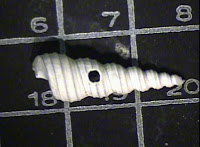Sample processing can be a lot of work! Sorting shells involves filtering through sand, dirt, and other debris to retrieve fauna (gastropods, bivalves, etc.). In addition to identification and counting, these samples are also measured and weighed as well as sorted for drill holes. A drill hole is exactly what it sounds like: a hole made by a drill. In this case, the “drill” is the tiny rasping tongue of a predatory marine snail. These snails use their tongue (called a radula) to “drill” through shells to consume their prey. Drill holes can be an important source of information to scientists because they are a preserved record of a predation event. Having this record in the form of holes in shells is valuable, because the majority of ecological interactions do not leave any record or trace behind, and are therefore impossible for paleontologists to detect. The study of interactions between organisms on the fossil record is called “paleoecology”, and drill holes offer a rich source of paleoecological information.
Here are images of what a drill hole in a gastropod shell looks like, and of sorting a sample for the presence of drill holes.
